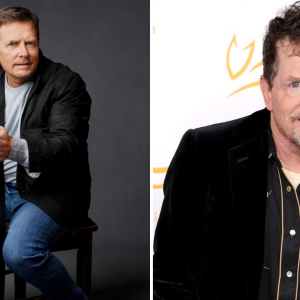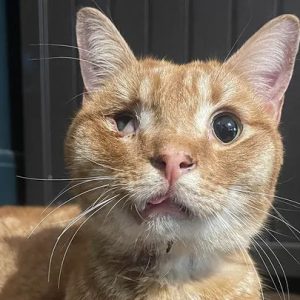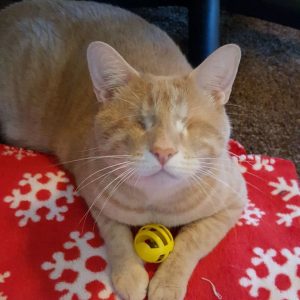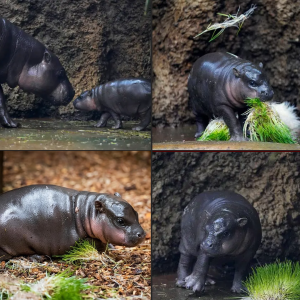This year marks the 59th annual iteration of the contest, which is developed and produced by the Natural History Museum in London. An international judging panel selected 25 top-notch images for the shortlist from a pool of just under 50,000, representing 95 countries. The images on the shortlist are all on display at the museum until June 30. But the final stage of judging is up to the public: To win the prestigious People’s Choice Award, a photograph must become the favorite in a popular vote.
Here are the 25 stunning images vying for the title of People’s Choice.
Tender Touch by Andy Parkinson
/https://tf-cmsv2-smithsonianmag-media.s3.amazonaws.com/filer_public/8f/62/8f624273-5211-4954-8db8-ed59bc706c8f/andy_parkinson_wildlife_photographer_of_the_year.jpg)
When these two courting mountain hares came together, U.K.-based photographer Andy Parkinson expected the female to reject the male’s advances. In such cases, the female hare will stand on her hind legs and flail her front arms in a dramatic “boxing match.” But instead, the pair came nose-to-nose during a delicate encounter.
The photograph, captured in the Monadhliath Mountains of Scotland, “reveals a moment of magic, a moment of exquisite tenderness that, in 20 years of photographing these beautiful mammals, I have never witnessed before or since,” Parkinson writes on Instagram.
The Happy Turtle by Tzahi Finkelstein
/https://tf-cmsv2-smithsonianmag-media.s3.amazonaws.com/filer_public/4c/09/4c09c899-bdf5-4c8f-b2c8-dd9e0cb6cf8d/tzahi_finkelstein_wildlife_photographer_of_the_year.jpg) A turtle appears to smile as a dragonfly alights on its nose. Tzahi Finkelstein / Wildlife Photographer of the Year
A turtle appears to smile as a dragonfly alights on its nose. Tzahi Finkelstein / Wildlife Photographer of the Year
Israeli photographer Tzahi Finkelstein largely ignored this Balkan pond turtle when he first saw it while taking pictures of birds in Israel’s Jezreel Valley. The turtle walked alone in the shallow water for a while, but then, a northern banded dragonfly flitted past Finkelstein’s lens and paused on the reptile’s nose.
Rather than consuming the insect, the turtle tipped its head upward and opened its mouth in what looked to the photographer to be a pleasured grin.
Ice Bed by Nima Sarikhani
/https://tf-cmsv2-smithsonianmag-media.s3.amazonaws.com/filer_public/ff/fc/fffcae5e-f106-43b1-8a41-9d7a344a3c2a/nima_sarikhani_wildlife_photographer_of_the_year.jpg)
After a fruitless three-day search for polar bears aboard an expedition vessel off the coast of the Svalbard archipelago in Norway, the U.K.-based photographer Nima Sarikhani finally laid eyes on two of the massive creatures. The boat had changed course, taking its crew to the southeast, where more sea ice floated on the ocean’s surface.
There, two male polar bears were visible on the ice, and Sarikhani watched them for eight hours. With his claws, the younger bear scraped away at the snow on the iceberg’s small peak just before midnight, creating a makeshift bed that he promptly settled into.
Missed Sip of Milk by Karim Iliya
/https://tf-cmsv2-smithsonianmag-media.s3.amazonaws.com/filer_public/c6/37/c637a90c-57a5-4346-aab9-0055e6627cea/karim_iliya_wildlife_photographer_of_the_year.jpg) A humpback whale calf swims next to a wisp of its mother’s milk in the water. Karim Iliya / Wildlife Photographer of the Year
A humpback whale calf swims next to a wisp of its mother’s milk in the water. Karim Iliya / Wildlife Photographer of the Year
For a young humpback whale, nursing can be kind of clumsy. Whales and dolphins do not have lips, so they can, on rare occasions, miss some of their mother’s milk, losing it to the ocean. American and Lebanese photographer Karim Iliya has spent hundreds of hours photographing humpback whales, but he’s only seen milk float through the water twice.
He was diving off the coast of Rurutu in French Polynesia, photographing one of these swirls of milk, when an even rarer image presented itself. The calf swam up in the background, just as Iliya was preparing to head back to the surface to take a breath.
“I fought my urge to breathe, as this opportunity might only come once in my life,” Iliya writes on Instagram. “I refocused my camera and managed to get a few photographs of the calf and the milk before making my way up for air.”
Starling Murmuration by Daniel Dencescu
/https://tf-cmsv2-smithsonianmag-media.s3.amazonaws.com/filer_public/ed/03/ed038f27-2ce0-4bab-8bfb-11f0513793cd/daniel_dencescu_wildlife_photographer_of_the_year.jpg)
German-Romanian photographer Daniel Dencescu spent hours following this immense group of starlings through the streets and suburbs of Rome. Each day, when the birds returned from foraging, they would congregate in the sky and move through mesmerizing aerial displays known as murmurations, before retiring to their communal roosts.
As they fly, the masses of starlings sometimes appear to form shapes, and on this cloudless day, they briefly depicted a giant bird, and Dencescu immortalized the moment.
Rubbish Drinks by Claire Waring
/https://tf-cmsv2-smithsonianmag-media.s3.amazonaws.com/filer_public/98/2e/982e78a2-9fe4-4b39-86f2-2e594536262b/claire_waring_wildlife_photographer_of_the_year.jpg) Surrounded by plastic waste, a Celebes crested macaque lifts a bottle to its mouth on a beach at Tangkoko Batuangus Nature Reserve in Indonesia. Claire Waring / Wildlife Photographer of the Year
Surrounded by plastic waste, a Celebes crested macaque lifts a bottle to its mouth on a beach at Tangkoko Batuangus Nature Reserve in Indonesia. Claire Waring / Wildlife Photographer of the Year
A monkey lifts a plastic bottle to its mouth on a beach covered in them, in this image by photographer Claire Waring of the U.K. At Indonesia’s Tangkoko Batuangus Nature Reserve, rangers collect the refuse and deposit it in heaps before transporting it away for recycling.
At the same time, Celebes crested macaques visit the piles of plastic to try and get liquid out of the containers. The primates have figured out that the colored bottles often have a sugary substance inside, so they select for these and chew through the caps to reach the drink, per a statement. On occasion, the monkeys will snatch some of the bottles and carry them into the forest, in opposition to the rangers’ recycling efforts.
Looking at Me, Looking at You by John E. Marriott
/https://tf-cmsv2-smithsonianmag-media.s3.amazonaws.com/filer_public/64/2c/642ca119-c111-4326-865f-401fc5a4a790/john_e_marriott_wildlife_photographer_of_the_year.jpg)
Canadian photographer John E. Marriott spotted this grizzly bear while leading a photography tour along the Chilko River in British Columbia. As the group’s small boat drifted past the animal with the current, it rose to its hind legs, likely to get a better view of the salmon below the surface.
Then, for just a moment, the bear made eye contact with Marriott’s camera before returning to fish.
Swallow Over Meadow by Hermann Hirsch and Jan Lessmann
/https://tf-cmsv2-smithsonianmag-media.s3.amazonaws.com/filer_public/26/1d/261deb16-4fe3-427d-bc80-5b3cf45adec2/hermann_hirsch_and_jan_lessman_wildlife_photographer_of_the_year.jpg) A barn swallow flies above a meadow of blue cornflowers to catch insects in eastern Germany. Hermann Hirsch and Jan Lessmann / Wildlife Photographer of the Year
A barn swallow flies above a meadow of blue cornflowers to catch insects in eastern Germany. Hermann Hirsch and Jan Lessmann / Wildlife Photographer of the Year
Barn swallows, small birds with blue backs and wings, return year after year to the same nest sites. German photographers Hermann Hirsch and Jan Lessmann knew the birds would come back to an old farm in the eastern part of the country, so they made a trip to try and image the creatures.
They placed their camera among the cerulean-hued cornflowers in a nearby meadow and waited for one of the swallows to fly overhead. Using a remote shutter, they snapped this image as one of the birds passed above, framed amid the blossoms against a white sky.
A Rare Sight by Axel Gomille
/https://tf-cmsv2-smithsonianmag-media.s3.amazonaws.com/filer_public/27/9c/279c91b9-84cd-45dc-b4f7-2ad2accaa99d/axel_gomille_wildlife_photographer_of_the_year.jpg)
This lounging Ethiopian wolf is one of just a few hundred of its kind in the world. The species is the planet’s rarest wild dog, threatened by habitat loss and diseases caught from domestic dogs, such as canine distemper and rabies.
To take this image, German photographer Axel Gomille went to Bale Mountains National Park in Ethiopia. The park hosts the largest population of these rare wolves. Gomille spotted this one, framed by colorful flowers, and captured its portrait.
Duckling Huddle by Charles Davis
/https://tf-cmsv2-smithsonianmag-media.s3.amazonaws.com/filer_public/b6/6e/b66ee17e-3e5b-475e-aa0a-e329d0ec4735/charles_davis_wildlife_photographer_of_the_year.jpg) A mother wood duck’s feathers ruffle in the wind as her ducklings huddle together during a late spring snow storm in New South Wales, Australia. Charles Davis / Wildlife Photographer of the Year
A mother wood duck’s feathers ruffle in the wind as her ducklings huddle together during a late spring snow storm in New South Wales, Australia. Charles Davis / Wildlife Photographer of the Year
Young wood ducks are known for jumping dramatically from their nests in trees after they hatch. But usually, they don’t leap into a snowy landscape. When Australian photographer Charles Davis captured this image, however, the La Niña weather pattern had resulted in a cooler and wetter spring in eastern Australia, bringing an unusual snow storm at a time when it’s typically warm and sunny.
Having just emerged into the frozen world, the ducklings huddled together as their mother prompted them to move toward open water. “After being blown over and wandering very far for little tiny legs, they did find their way to safety in a creek,” Davis writes on Instagram. “A truly once in a lifetime thing to witness.”
Opportunity Fox by Matt Maran
/https://tf-cmsv2-smithsonianmag-media.s3.amazonaws.com/filer_public/f1/2e/f12e8679-da03-4963-8f82-bac04705df2c/matt_maran_wildlife_photographer_of_the_year.jpg)
United Kingdom-based photographer Matt Maran spent two months watching this young red fox prowl the streets of London. The fox appeared to understand that the best time to raid this trash bin was on Monday evenings—right before the weekly collection time.
Though the fox has been captured dining on litter in this photo, that’s not likely to be its full diet. “It is undeniable that foxes have adapted well to urban environments and make use of our discarded food to survive. However, it may surprise you to learn that the majority of their diet consists of natural food sources,” Maran writes on Instagram. More than half of what city-dwelling foxes eat comprises birds, earthworms, seeds, fruits, insects and small mammals.
The Grassland Geladas by Marco Gaiotti
/https://tf-cmsv2-smithsonianmag-media.s3.amazonaws.com/filer_public/da/d1/dad1f030-c00c-4c2d-81f6-73b98756a815/marco_gaiotti_wildlife_photographer_of_the_year.jpg) Two gelada monkeys and a baby sit in Ethiopia’s Simien Mountains, with rain clouds looming in the background. Marco Gaiotti / Wildlife Photographer of the Year
Two gelada monkeys and a baby sit in Ethiopia’s Simien Mountains, with rain clouds looming in the background. Marco Gaiotti / Wildlife Photographer of the Year
Italian photographer Marco Gaiotti captured an intimate moment for this family of gelada monkeys, as a mother nurses her young. The second adult is another female, since the family structure for geladas often consists of one male, a “harem” of related females and their young.
Unlike other primates, geladas primarily eat grass. They’re the last remaining species of the ancient grazing primates, which once were plentiful, according to National Geographic. But now, as domestic livestock raising increases in the area, the monkeys’ range is becoming more restricted as the grasslands they rely on to survive gradually disappear.
Troublemaker by Stefan Christmann
/https://tf-cmsv2-smithsonianmag-media.s3.amazonaws.com/filer_public/92/95/929574f7-4645-4c0e-8455-d61f6df1119e/stefan_christmann_wildlife_photographer_of_the_year.jpg)
In a potential prelude to an altercation, an Adélie penguin approaches an emperor penguin and its chick, hoping to snatch a bit of food. Adélies are only present in Antarctica’s Atka Bay, where this image was taken, for a short time during the Southern Hemisphere’s summer. But while there, these “opportunists” will take advantage of emperor penguins’ chick-feeding time, per a statement.
“Whenever the emperor parent was trying to feed the chick, the Adélie would try to disturb the chick, hoping that part of the meal would land on the ground,” German photographer Stefan Christmann writes on Instagram. “In case that happened, the Adélie would swiftly pick up the spilled goods and run off into the distance—using the unmistakable Adélie waddle walk.”
Aurora Jellies by Audun Rikardsen
/https://tf-cmsv2-smithsonianmag-media.s3.amazonaws.com/filer_public/00/f6/00f6d65e-2eda-4957-ac5d-4fa6b6d8a882/audun_rikardsen_wildlife_photographer_of_the_year.jpg) Beneath the northern lights, moon jellyfish appear to glow in a fjord outside Tromsø, Norway. Audun Rikardsen / Wildlife Photographer of the Year
Beneath the northern lights, moon jellyfish appear to glow in a fjord outside Tromsø, Norway. Audun Rikardsen / Wildlife Photographer of the Year
Two moon jellyfish swim underneath the blue-green aurora borealis. The jellies—recognizable by the four teardrop-shaped structures on their bells, which are actually their reproductive organs—sometimes gather by the hundreds below the celestial light show.
This image was taken “just a few hundred meters” from Norwegian photographer Audun Rikardsen’s house, he writes on Facebook. He took the photograph with a single exposure but adjusted the aperture and focus during the shot. In this way, he managed to simultaneously image the jellies with flashes and capture the aurora’s reflection.
Neighborhood Dispute by Ofer Levy
/https://tf-cmsv2-smithsonianmag-media.s3.amazonaws.com/filer_public/ee/b6/eeb602f7-7e02-48b6-8f60-8e1a1d8437e9/ofer_levy_wildlife_photographer_of_the_year.jpg)
Mudskippers are amphibious fish that can—out of water—breathe through their skin and gills, provided they remain wet. They build burrows surrounded by mud walls, which they often climb on top of to gain a favorable vantage point, watching for food, predators or animals that invade their territory.
Australian photographer Ofer Levy was privy to a disagreement between a mudskipper and a crab in the fish’s domain. He watched and photographed as the mudskipper repeatedly initiated the aggression, opening its mouth and raising its dorsal fin in a threatening manner.
Homecoming by Dvir Barkay
/https://tf-cmsv2-smithsonianmag-media.s3.amazonaws.com/filer_public/97/1b/971bfcd0-02e1-44f2-98f9-383fb9ac5987/dvir_barkay_wildlife_photographer_of_the_year.jpg) A pygmy round-eared bat returns to its home, carved from a termite nest in Costa Rica. Two of its family members, well-camouflaged, can be seen in the entrance. Dvir Barkay / Wildlife Photographer of the Year
A pygmy round-eared bat returns to its home, carved from a termite nest in Costa Rica. Two of its family members, well-camouflaged, can be seen in the entrance. Dvir Barkay / Wildlife Photographer of the Year
In the lowland forests of Costa Rica, pygmy round-eared bats use their teeth to carve holes in termite nests, which they use as their homes. American-Israeli photographer Dvir Barkay wanted to capture the animals returning to the roost, so he scoured the forests for the bats’ hollows. When he found this site, he set up a camera on a nearby branch and arranged three diffused flashes. An infrared sensor would trigger the flash when it detected a bat in the frame.
He spent two months in the field trying to capture a photograph like this one. “Most nights ended with no good images,” Barkay writes on Instagram, since the bats only returned to the roost two or three times per night, and their wing position wasn’t always photogenic. “But many long nights and mosquito bites later, I was able to capture this image.”
Curiosity by Gerald Hinde
/https://tf-cmsv2-smithsonianmag-media.s3.amazonaws.com/filer_public/68/bf/68bfd184-64d3-42a1-99cb-8e3a5f6f6521/gerald_hinde_wildlife_photographer_of_the_year.jpg)
To capture this curious lion cub at eye level, South African photographer Gerald Hinde leaned out of his vehicle, holding the camera close to the ground. He had parked in a river bed in South Africa’s Greater Kruger National Park, and this youngster was the first to take an interest and approach him.
As the cub wandered away, its mother looked on with a watchful eye. Lion cubs can become prey for hyenas or leopards, but frequently, their biggest threat comes from adult male lions looking to take over a pride. The cubs are protected by their mothers for six weeks, then the duty of care is spread among all the pride’s members, per a statement.
Snowshoes by Deena Sveinsson
/https://tf-cmsv2-smithsonianmag-media.s3.amazonaws.com/filer_public/fd/db/fddba799-dec9-4634-836f-4d6323729769/deena_sveinsson_wildlife_photographer_of_the_year.jpg) A snowshoe hare pulls its back feet to either side of its head as it hops across the snow in Rocky Mountain National Park. Deena Sveinsson / Wildlife Photographer of the Year
A snowshoe hare pulls its back feet to either side of its head as it hops across the snow in Rocky Mountain National Park. Deena Sveinsson / Wildlife Photographer of the Year
Patience was key to American photographer Deena Sveinsson’s capture of this acrobatic snowshoe hare. While walking through Rocky Mountain National Park, she noticed the creature sleeping on a pile of snow and waited for it to wake. It took hours, but when the hare finally opened its eyes and began to hop across the landscape, Sveinsson clicked the shutter using a high frame rate to capture movement.
To reach the site where she took this photograph, Sveinsson had to wear snowshoes. The hares, in a sense, have snowshoes of their own: Their massive feet distribute their weight across a wide area, allowing them to cross lightly over the surface of the packed down snow.
Bull in a Garbage Dump by Brent Stirton
/https://tf-cmsv2-smithsonianmag-media.s3.amazonaws.com/filer_public/df/98/df9803aa-9961-4a3f-b7c9-35b5776a3e29/brent_stirton_wildlife_photographer_of_the_year.jpg)
South African photographer Brent Stirton watched this male elephant traipse through a garbage dump in Sri Lanka, searching for fruits and vegetables that may have been thrown away.
But beyond the vegetables that lie among piles of trash, this dump is near crop fields, highlighting another problem for elephants. When the massive mammals wander toward the fields, humans will try to deter them with loud noises or fireworks. If that doesn’t work, they resort to shooting, and this elephant—with a scar on its leg and wound on its back—appears to have tried to get crops in the past. According to a statement, the shots are “seldom fatal.”
Tough Negotiation by Ayala Fishaimer
/https://tf-cmsv2-smithsonianmag-media.s3.amazonaws.com/filer_public/b0/fc/b0fcd0c4-9b10-47ad-a284-e4b82390ec64/ayala_fishaimer_wildlife_photographer_of_the_year.jpg) A red fox and a shrew lock eyes as the cub plays with the rodent in the Judean Foothills of Israel. Ayala Fishaimer / Wildlife Photographer of the Year
A red fox and a shrew lock eyes as the cub plays with the rodent in the Judean Foothills of Israel. Ayala Fishaimer / Wildlife Photographer of the Year
Following the first Covid-19 lockdown, Israeli photographer Ayala Fishaimer drove an hour from her residence to the Judean Foothills to watch red fox cubs outside their den. She parked a safe distance away from the animals’ home, then waited until four playful cubs appeared.
One of the foxes became distracted and started sniffing around. Then, it pulled a shrew from the sand. The cub played with the rodent, even tossing it into the air once. Fishaimer captured this photo in the moment after the shrew fell back to the ground, when the two animals met each other’s gaze.
Incoming Cuckoo Wasp by Frank Deschandol
/https://tf-cmsv2-smithsonianmag-media.s3.amazonaws.com/filer_public/bd/64/bd64c728-3f30-4bb1-9748-cf992651f981/frank_deschandol_wildlife_photographer_of_the_year.jpg) A cuckoo wasp hovers outside the nest of a mason bee in France, as another cleans its wings. Frank Deschandol / Wildlife Photographer of the Year
A cuckoo wasp hovers outside the nest of a mason bee in France, as another cleans its wings. Frank Deschandol / Wildlife Photographer of the Year
French photographer Frank Deschandol set out to capture pictures of the parasitic cuckoo wasp near Montpelier, France. Knowing that these insects target mason bees, he placed his camera near the nest of one of the expert builders. Soon enough, a cuckoo wasp approached the bee’s nest, “hovering several times for tens of seconds like a hummingbird,” the photographer writes on Instagram. Another cuckoo wasp, this one of a different species, sat on the nest and cleaned its wings.
The drop of water at the airborne wasp’s mouth was a surprise to Deschandol—he didn’t notice it was there until after he looked back at the photo he’d captured. Cuckoo wasps use this water and saliva to soften the clay surrounding a mason bee’s burrow and dig inside. There, they’ll lay an egg, exit the burrow and seal it up once more. When the egg hatches, the young wasp will eat the mason bee’s larvae.
Shared Parenting by Mark Boyd
/https://tf-cmsv2-smithsonianmag-media.s3.amazonaws.com/filer_public/d8/26/d826ae7c-fdc2-4322-a747-f3c82ef5f23a/mark_boyd_wildlife_photographer_of_the_year.jpg) A lion cub gets a “bath” from a pair of lionesses in a pride at Kenya’s Maasai Mara National Reserve. Mark Boyd / Wildlife Photographer of the Year
A lion cub gets a “bath” from a pair of lionesses in a pride at Kenya’s Maasai Mara National Reserve. Mark Boyd / Wildlife Photographer of the Year
While hunting overnight at Maasai Mara National Reserve in Kenya, a pride of female lions hid their cubs in the bushes. Upon their return, the lionesses called their five young out to the grassland and began cleaning one of them. Photographer Mark Boyd of Kenya captured a tender moment between two of the pride’s lionesses, which share parenting responsibilities, and one of the cubs.
Autumn Glow by Uge Fuertes Sanz
/https://tf-cmsv2-smithsonianmag-media.s3.amazonaws.com/filer_public/fa/65/fa652d7c-283c-4fd5-b990-f017fab08a14/uge_fuertes_sanz_wildlife_photographer_of_the_year.jpg) Quaking aspens and cattails in Spain’s Sierra de Albarracin Mountains are bathed in soft autumn light. Uge Fuertes Sanz / Wildlife Photographer of the Year
Quaking aspens and cattails in Spain’s Sierra de Albarracin Mountains are bathed in soft autumn light. Uge Fuertes Sanz / Wildlife Photographer of the Year
Spanish photographer Uge Fuertes Sanz waited for a cloud to pass over this serene scene, bathing it in diffuse light that created a soft glow. On the banks of the River Cabriel in Spain’s Sierra de Albarracin Mountains, he took more than one hundred images.
Behind the pale trunks of quaking aspens and bright orange autumn leaves are rows of cattails, and together, the composition looked to the photographer as if it had been painted, per a statement.
Fashion Victims by Britta Jaschinski
/https://tf-cmsv2-smithsonianmag-media.s3.amazonaws.com/filer_public/d6/be/d6be7509-1ac2-4b16-8a2c-f9ca84f9244a/britta_jaschinski_wildlife_photographer_of_the_year.jpg) These coats were made from the skins of endangered big cats and confiscated by European customs officers. After forensic testing, they became part of educational events. Britta Jaschinski / Wildlife Photographer of the Year
These coats were made from the skins of endangered big cats and confiscated by European customs officers. After forensic testing, they became part of educational events. Britta Jaschinski / Wildlife Photographer of the Year
Ocelots, jaguars and snow leopards rank among the most endangered big cats in the world. But here, their skins have been used to make fur coats. The ones pictured in this image were confiscated by customs officers across Europe and held at the Leibniz Institute for the Analysis of Biodiversity Change in Hamburg, Germany, for analysis.
“I was shocked to learn that it takes several individuals and sometimes up [to] 12 big cats to make one fur coat,” German-U.K. photographer Britta Jaschinski writes on Instagram. By confiscating these and, later, using them in educational programming, officials aim to never let them return to the black market.
Hope by Roberto García-Roa
/https://tf-cmsv2-smithsonianmag-media.s3.amazonaws.com/filer_public/59/99/5999ea65-4741-4f51-b764-bb0f0192bf32/roberto_garcia-roa_wildlife_photographer_of_the_year.jpg) A rescued chimpanzee at the Chimpanzee Conservation Center in the Republic of Guinea looks out from its cage into the camera. Roberto García-Roa / Wildlife Photographer of the Year
A rescued chimpanzee at the Chimpanzee Conservation Center in the Republic of Guinea looks out from its cage into the camera. Roberto García-Roa / Wildlife Photographer of the Year
Western chimpanzees in the Republic of Guinea were once common, but now, their numbers have dropped so dramatically that they’re classified as a critically endangered species. Chimpanzees face threats of deforestation, expanding agriculture and poaching, which can leave their young orphaned and sometimes sold as pets.
But the country’s Chimpanzee Conservation Center takes in the babies and rehabilitates them, in hopes of releasing the primates to the National Park of Upper Niger. Spanish photographer Roberto García Roa took this portrait of one of the rescued primates at the center, which also works with local communities to spread information about conserving chimpanzees.
“The conservation efforts carried out by sanctuaries and institutions across Africa to save this group of primates provide a glimmer of hope for imagining a future where western chimpanzees find their rightful place,” writes the photographer on Instagram.





